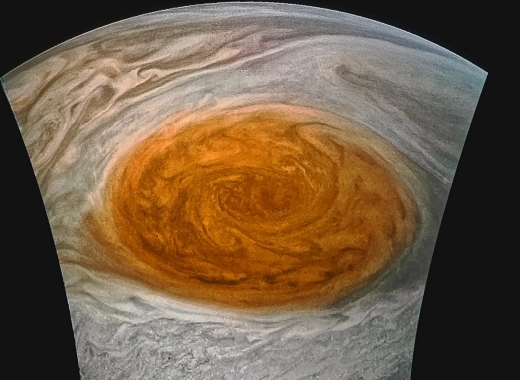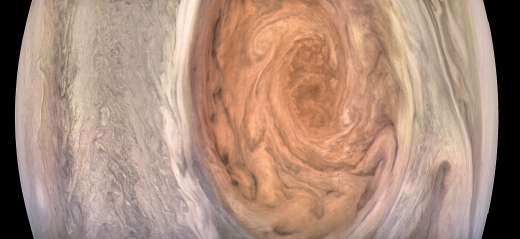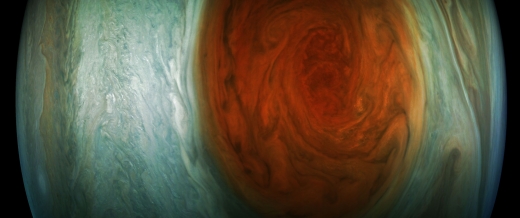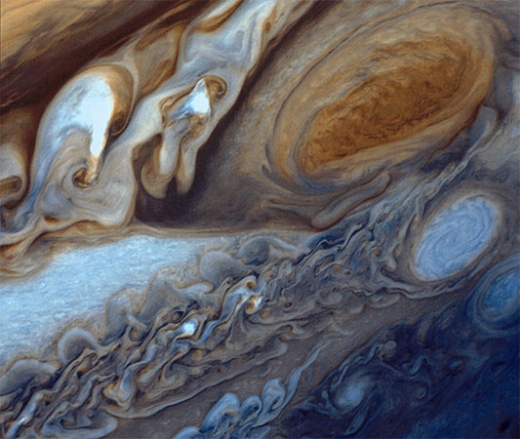All of the Juno spacecraft’s instruments — including JunoCam — were operational during its July 10 flyby, giving us a close-up look at the Great Red Spot. Now 16,000 kilometers wide, the storm has been studied since 1830 and may be considerably older than that. Juno’s orbit took it to perijove (closest to Jupiter’s center) at 2155 EDT on the 10th (0155 UTC on the 11th), when it closed to about 3500 kilometers above the cloud tops. The passage across the Great Red Spot occurred eleven minutes later at some 9000 kilometers above the clouds.
While the data are being unpacked and analyzed, we can enjoy the efforts of citizen scientists who went to work on the raw images posted on the JunoCam site and processed them, a procedure done in coordination with the Juno team.
“These highly-anticipated images of Jupiter’s Great Red Spot are the ‘perfect storm’ of art and science. With data from Voyager, Galileo, New Horizons, Hubble and now Juno, we have a better understanding of the composition and evolution of this iconic feature,” said Jim Green, NASA’s director of planetary science. “We are pleased to share the beauty and excitement of space science with everyone.”

Image: This enhanced-color image of Jupiter’s Great Red Spot was created by citizen scientist Jason Major using data from the JunoCam imager on NASA’s Juno spacecraft. The image was taken on July 10, 2017 at 07:10 p.m. PDT (10:10 p.m. EDT), as the Juno spacecraft performed its 7th close flyby of Jupiter. At the time the image was taken, the spacecraft was about 13,917 kilometers from the tops of the clouds of the planet. Credit: NASA/JPL-Caltech/SwRI/MSSS/Jason Major.
And let’s go through the two others just posted by JPL.The one below was created by Kevin Gill, likewise working with raw data from the JunoCam imager.

And a final image from citizen scientist Gerald Eichstädt.

The English natural philosopher Robert Hooke (1635-1703) described what may have been the Great Red Spot in 1664, although he seems to have placed it on the wrong side of the Jovian equator, making the sighting problematic. The following year, however, Giovanni Cassini detected a ‘permanent storm’ that remained under observation into the 18th Century, although there are no observations between 1713 and 1830. The first certain record of the Great Red Spot occurs in an 1831 drawing by German amateur Samuel Heinrich Schwabe.
The red coloration of the Great Red Spot is problematic, with suggestions ranging from compounds of sulfur and phosphorus to organic material produced by high-altitude photochemical reactions or lightning discharges. The Voyager spacecraft returned spectacular imagery, including the Voyager 1 image in 1979 shown below, which revealed details as small as 160 kilometers and highlighted the spectacularly complex wave motion west of the Spot.

Image: Jupiter’s Great Red Spot (top right) and the surrounding region, as seen from Voyager 1 on March 1, 1979. Below the spot is one of the large white ovals associated with the feature. NASA/JPL
Since the Voyager encounters (and indeed, since the late 19th Century) the Spot has been shrinking. Voyager measured its length at 23,000 kilometers, and since 2012 it has been diminishing at a rate of about 900 kilometers per year. We’ll see what Juno can tell us about the giant storm’s energy source and its longevity as data are processed in the weeks ahead.



In one (or maybe both) of my 1950s-vintage childhood astronomy books (“Our Sun and the Worlds Around It” or “Planets: Other Worlds of Our Solar System”–I still have them, but they’re packed away at the moment), the length of the Great Red Spot is given as 25,000 miles, so it has shrunk significantly–although it still dwarfs our Earth–to be “only” 16,000 km (10,000 miles) long today, and:
If one regards the Great Red Spot (for descriptive purposes, even if it isn’t really mathematically so) as being elliptical in shape, its “eccentricity” has definitely decreased over the last several decades, as it is now more nearly circular than it was in the 1950s, or even in 1973/74 and 1979, when Pioneer 10 & 11 and Voyager 1 & 2 encountered Jupiter, respectively. Now:
To Pioneer 10 in December 1973, the spot was shaped like a “holiday” or “Dutchman”–that is, like an (American) football-shaped plywood patch (see: http://wisp.physics.wisc.edu/astro104/lecture20/F13_04a.jpg [here is a photo of two of the “holiday” or “Dutchman” plywood patches, for comparison: http://cr4.globalspec.com/PostImages/201304/Patch_D1652DFB-C971-2B12-7DF60D44394628AF.jpg ); a year later, Pioneer 11 viewed it as being an elongated “rough” ellipse (see: http://wisp.physics.wisc.edu/astro104/lecture20/F13_04b.jpg ). The Voyagers saw it “in both of these aspects,” too, as well as in the forms of a sometimes more-eccentric (as Pioneer 11 saw), sometimes less-eccentric ellipse (see: http://www.google.com/search?q=Voyager+Great+Red+Spot&tbm=isch&tbo=u&source=univ&sa=X&ved=0ahUKEwjH7JfktIbVAhVUHGMKHRtPBTEQsAQIKA&biw=1440&bih=794#imgrc=zztoz57fRMB86M: ), as well as in the forms of a sometimes more-eccentric (as Pioneer 11 saw), sometimes less-eccentric ellipse, and:
These short-term changes in the spot’s shape suggest that some cyclical phenomenon may have been responsible. Other online articles about this close-up JunoCam photo session have suggested that the spot’s shrinkage in overall size might be due either to it slowly “dying out,” or to some longer-term cycle. (In past centuries, the spot has faded in color and virtually vanished, only to “rebound” later, which makes me inclined to accept the latter hypothesis, that some long-term cycle is at work). Plus:
I wonder if any correlations between the solar cycle and the Great Red Spot’s size and/or color have ever been seen? In addition to the familiar 11-year solar cycle, there are suspected to be other, longer-term cycles which–when they “fall” together–cause unusually great (or unusually minimal) solar activity. If the Great Red Spot’s color and/or size are even partly influenced by incoming solar light (it’s ~1/27th as intense as what the Earth and Moon receive) and/or particles, perhaps the Sun is at least partly responsible for changes in the spot?
‘The English natural philosopher Robert Hooke (1635-1703) described what may have been the Great Red Spot in 1664, although he seems to have placed it on the wrong side of the Jovian equator, making the sighting problematic.’
The image is inverted in the telescope, so he may have been right.
It would depend on the telescope he used; he probably used his “12 foot” telescope as a “Keplerian” telescope with the eyepiece outside the focal point. The image would have been inverted.
If he used it with a negative lens, like Galileo, the image would have been right side up but I doubt he would have used it this way.
Hooke also made the first Georgian telescope, which also produces a right side up image.
I cannot find a source at the moment but I read in an issue of Astronomy on or around 1980 that Johannes Kepler may have seen the GRS – or it may have just been once heck of a coincidence.
As I recall Kepler sent an anagram to Galileo, as astronomers often did back then to keep discoveries secret so they would get first credit. I cannot recall exactly what the real anagram was supposed to be – maybe Venus has phases like the Moon, I think – but when Galileo first translated the anagram he got something like “There is a red spot on Jupiter.”
I do not know if any telescopes in the early 1600s were powerful enough to image the GRS, but it is a very intriguing event, even more so than Kepler or Jonathan Swift saying that Mars had two moons long before they were discovered in 1877, in my opinion.
If someone could help with the details on this, I would appreciate it. A fascinating story.
http://www.cbsnews.com/pictures/jupiters-great-red-spot/4/
If anyone recalls the book Planets from the Time-Life Science series first published in 1966, with Carl Sagan as its science advisor, there was a section devoted to Jupiter. One part discusses the nature of the GRS, which includes a big, beautiful piece of artwork depicted the GRS as a huge red oval cloud floating above a denser layer of clouds below. The GRS was apparently translucent enough that sunlight could shine through it to project a reddish oval shadow below.
This was the explanation in the book for why the GRS expanded and contracted over the centuries. The explanation of it being a huge hurricane would have to wait for space probes, unless someone knows if this was one explanation pre Space Age?
I have that book–the painting renders the atmosphere transparent (yet still visible) so that the “elliptical cross-section conical column” that is the Great Red Spot can be traced down into the planet. If memory serves, the working hypothesis then was that Jupiter had a solid core, and that the spot was “rooted” to either a depression or a huge mountain-like feature in (or on) the surface of the core. According to this hypothesis, the spot was a column of relatively calm air, around which the rest of the atmosphere flowed.
Bravo JUNO! And kudos to the Malin group for providing the camera!
Another extraordinary cosmic event that happened at and with Jupiter this week in 1994:
http://www.americaspace.com/2017/07/17/remembering-comet-shoemaker-levy-9s-impact-on-jupiter-23-years-ago-this-week/